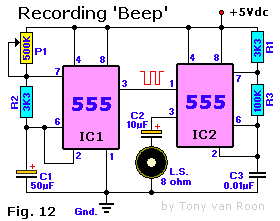


CW Monitor: This circuit monitors the morse code 'on-air' via the tuning circuit hookup to pin 4 and the short wire antenna. The 100K potmeter controls the tone-pitch.
Metronome: A Metronome is a device used in the music industry. It indicates the rhythm by a 'toc-toc' sound which speed can be adjusted with the 250K potentiometer. Very handy if you learning to play music and need to keep the correct rhythm up.
Error fixed with thanks to Grant Fair in regards to the two resistors. (Grant also added a PNP power transistor to increase the volume and a led for visual as well as audio output).
CW Practice Oscillator: CW stands for 'Continuous Wave' or Morse-Code. You can practice the morse-code with this circuit. The 100K potmeter is for the 'pitch' and the 10K for the speaker volume. The "Key" is a morse code key.
Electric Eye Alarm: The Electric-Eye Alarm is actually a similar circuit like the Dark Detector of Fig. 1. The same type of LDR is used. The pitch for the speaker can be set with the 500 kilo-ohm potentiometer. Watch for the orientation of the positive (+) of the 10uF capacitor. The '+' goes to pin 3.
Tilt Switch: Actually really a alarm circuit, it shows how to use a 555 timer and a small glass-encapsulated mercury switch to indicate 'tilt'.
The switch is mounted in its normal 'open' position, which allows the timer output to stay low, as established by C1 on startup. When S1 is disturbed, causing its contacts to be bridged by the mercury blob, the 555 latch is set to a high output level where it will stay even if the switch is returned to its starting position. The high output can be used to enable an alarm of the visual or the audible type. Switch S2 will silent the alarm and reset the latch. C1 is a ceramic 0.1uF (=100 nano-Farad) capacitor.
Dark Detector: It will sound an alarm if it gets too dark all over sudden. For example, this circuit could be used to notify when a lamp (or bulb) burns out. The detector used is a regular cadmium-sulphide Light Dependent Resistor or LDR, for short, to sense the absence of light and to operate a small speaker. The LDR enables the alarm when light falls below a certain level.
Recording Beep: This circuit is used to keep recording of telephone conversations legal. As you may know, doing otherwise without consent of the other party is illegal. The output of IC1 is fed to the 2nd 555's pin 3 and made audible via C2 and the speaker. Any 8-ohm speaker will do.
Two-Tones: The purpose of this experiment is to wire two 555 timers together to create a 2-note tone. If you wish, you can use the dual 556 timer ic.





1 comment:
one of your circuit is wrong because if you connect a 25 uf capacitor from output to an 8 ohms speaker might get very hot correct me if im wrong.....
Post a Comment